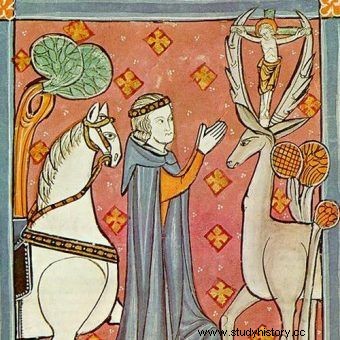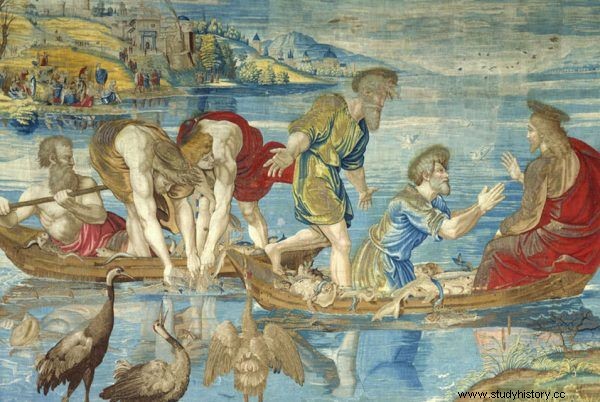Holy dog, mischievous female dog in paradise, resurrected goose ... Can the "little brothers" get to heaven without a soul? Of course. All they have to do is ... eat a man. Absurd? This is not what was believed in the Middle Ages!
According to tradition, when God created the animals on the fifth and sixth days, He established a hierarchy and placed them under Adam's authority, allowing him to give them names. It is known, however, that they did not receive a rational soul. So how would they get to heaven?
Jesus didn't like animals?
None of the animals in paradise were Adam's mate or companion, because only man was created in God's image . After the Flood, God further strengthened man's position towards animals by telling Noah: Everything that moves and lives is for your food, like green plants, I give you everything. (Genesis 9:3). 
Species marked by evil, such as snakes and scorpions, belonged to a separate group. Dogs and pigs were also at the bottom of the hierarchy, and over time Christianity began to associate them with depraved people such as pagans, unbaptized and sinners. In the parable of the healing of the possessed (Mark 5:1-20), Jesus allows the demons to enter the pigs, signaling that the animal will not be saved.

It is difficult to find any positive words from Jesus to animals in the Gospels. Arras by Pieter van Aelst based on a painting by Raphael (source:public domain).
Holy Vegetarians…
However, some lives of saints describe the fate of animals that rejected their predatory nature in their presence. Saint Paul of Thebes persuaded the lion to eat only bread . When the lion returned to his old practices, the saint drove him away with the words: You disobeyed me and ate the meat! In the name of our Lord, you carnivore, I will no longer feed you with the food of your fathers!
In the life of Saint Bartholomew, who died in the 12th century, there is an example of God's husband's unusual relationship with animals. When the duckling fell into a rock chasm, and his mother came to Bartholomew for help, the saint could not refuse. Especially that at the sight of the duck no one doubted that it was intelligent .

The miracles of Saint Werburg, including the resurrection of the goose, illustrated in Chester Cathedral (photo:Stephen Hamilton, license CC BY-SA 3.0).
Another example of God's chosen care for animals, additionally related to the miracle, is the life of Saint Verburga, written by William of Malmesbury. The saint first performed a miracle forbidding the geese to eat the grain, and when her maid ate one of the obedient geese, Werburga collected the bones and resurrected the unfortunate bird.
… and holy dog
In the late Middle Ages, the interspecies boundaries were blurred mainly thanks to the life of Saint Francis of Assisi, who did not shy away from seeing animal elements in himself. His biographer wrote: He used to call his body Brother Donkey, feeling the necessity to work hard, to whip and eat the worst food.
However, the most extreme example of a cult that completely nullified the traditional hierarchy of God's creation was the cult of Saint Guinefort, a dog from the Lyon area . According to legend, the infant was left at home with the dog when a snake crept into the room and approached the cradle.
The faithful pooch rushed to attack, and in the fight it got stained with the blood of the reptile. Upon their return, the parents found the dog with its mouth covered in blood. Thinking it was the blood of a baby, the master of the house killed him.
When they found the whole and safe child and the dead snake, everything became clear. The dog became a martyr. In the 12th century, Guinefort was venerated as the protector of children.

Could this group include another candidate for a saint who would protect the child with his own body? An illustration from "Livre de chasse" by Count Gaston Febus at the end of the 14th century (source:public domain).
One hundred years later, the Holy Inquisition tried to eradicate this cult, but it was practiced intensively until the end of the 19th century and even before the Second World War. People prayed through Guinefort's intercession and brought children's clothes to the vicinity of his grave.
We are all vermin
In the 4th century, Ambrose of Milan spoke about the sleepover question of his contemporaries, whether a body eaten by animals can be resurrected . In God's view, it will not be difficult to put the members back together. Likewise, Saint Augustine assured believers that the devoured would be resurrected and the body would return to its original owner.
However, in the thirteenth century, the scholastics began to think whether such a body would consist of animal elements. Of course, the puzzle was settled in favor of the people.
The early Church Fathers were also sure that animals did not have a rational soul, so they refused them life after death. However, since the human soul miraculously transformed the flesh of an animal into a human body, there were suggestions that it was through such an elevation that animals could enter Paradise.

The problem of the resurrection of bodies devoured by vermin deeply troubled Saint Augustine. Father and doctor of the Church in a painting by Philippe de Champaigne from around 1650 (source:public domain).
On the other hand, another puzzle appeared. If the body was not eaten by wild animals, fish or birds after death, then worms ate it. Saint Augustine then asked: All men born of the flesh, are they not also vermin? It was thought that a man could not be resurrected unless the animals were brought back to life.

Fragment of the mosaic depicting the Last Judgment in the Cathedral of Torcello, where you can see animals vomiting with fragments of human bodies (source:public domain).
Near Venice, in the Cathedral of Torcello, there is an 11th-century mosaic in which animals and fish resurrected on Judgment Day obediently vomit the parts of the human body they have eaten . So where are the animals that will be raised from the dead going to be?
Paradise garden without mosquitoes
The first problem of the Church Fathers was the question of what animals would actually be doing in heaven. It was not believed that they had any purpose other than serving man, be it food and clothing, or work. Thomas Aquinas made it clear that if a man in heaven would not need any of these things, animals were also redundant.
The situation was quite different with the images of heaven as a place full of earthly pleasures, a garden of paradise full of fruit trees and gentle animals. In the 15th century, famous people buried their animals in the hope of eternal life.

According to a poem by one of the courtiers, Izabella d'Este's bitch, mischievous Aura, went to heaven. Fragment of a painting by Titian from around 1535 (source:public domain).
And so the epitaph on the tombstone of a little dog named Viola said that she was now in heaven. One of the courtiers wrote a poem describing the ascension of the mischievous Auras , bitches Izabella d'Este.
Christians who wanted to see their pets after death could also seek comfort in the Holy Scriptures. In one of the Psalms we read: Lord, you bring salvation to people and animals (Psalm 36:7), and in the epistles of Saint Paul you can find the promise that all the earth will be saved and that Christ will unite what is in the heavens and what is on earth (Eph. 1:9-10).
Writer C.S. Lewis emphasized the possibility of salvation by animals, noting that less desirable species, such as tapeworms or mosquitoes, have no chance for the sky . He suggested that human companions are transformed by intercourse with humans, and that their immortality stems, as it were, from the immortality of their owners.
Thus, in the works of the 20th-century author, the early medieval anthropocentrism persisted - animals are not allowed into heaven, unless they are slippery favorites thanks to their masters.
A better sky seems to be from Isaiah (11:6-8), where a wolf would live with a lamb, a panther with a child, a lion would eat straw like an ox, and children could play with poisonous snakes without fear. It would be paradise!
